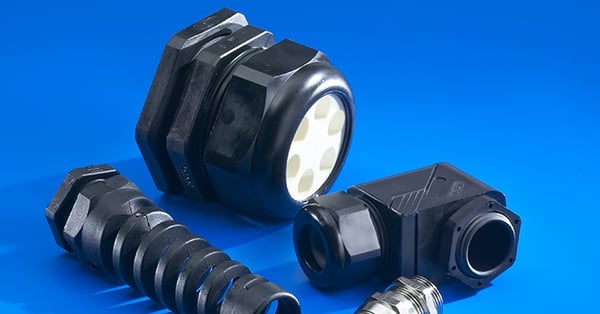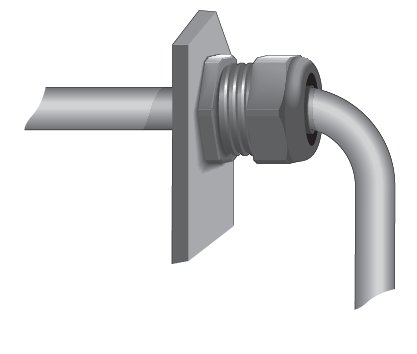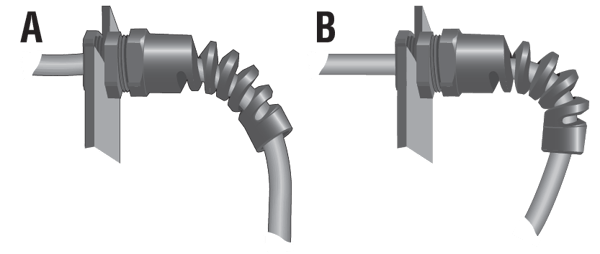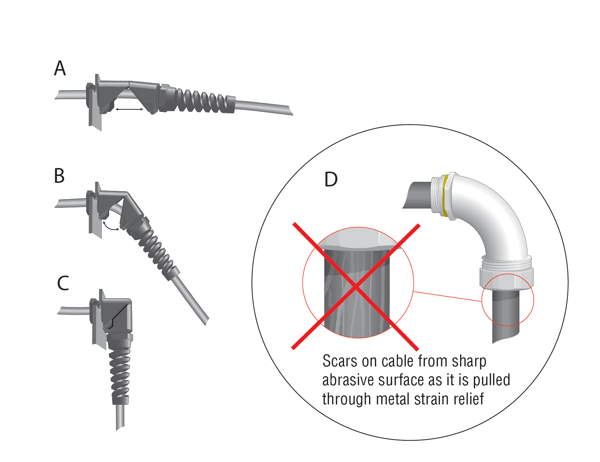Helping to Protect the Electrical Connection with a Strain Relief/Cable Gland
Posted on 11/19/18 3:26 PM

Strain reliefs, also known as cable glands, can have an important role in the design of equipment which uses power cords. The main purpose of a strain relief/cable gland is to help protect the electrical connection and circuitry inside the equipment. It helps to eliminate tugs or pulls on the power cord that could cause the wires to become disconnected resulting in injury, accident, or failure of equipment.
The term “strain relief” is commonly used in North America, while “cable gland” is commonly used throughout Europe and the other parts of the world.
Applications
The most common application of a strain relief/cable gland is on a power cord providing electricity to equipment. In many situations, the equipment is portable and requires protection so the cable cannot be pulled out of the equipment. Strain reliefs/cable glands are also used in connecting flexible conduit for control cables between pieces of equipment.
In each application, several important factors must be considered when selecting the correct strain relief/cable gland. These factors include: resistance to residual and applied moisture, dust, and chemicals. Equipment used in dusty or moist environments must have all openings sealed so they are resistant to the entry of dust or moisture. A strain relief/cable gland that holds the cable in place without protection from dust or moisture does little in protecting the internal components of the equipment.
Some equipment applications require that a strain relief/cable gland be able to withstand high-pressure cleaning. A strain relief/cable gland that seals out dust and moisture is necessary for protecting internal components of the equipment.
Body Styles
Specific body styles are available for many different applications. Typically, strain reliefs/cable glands are available in two general configurations: dome and flex.
Dome Style
Dome style strain reliefs/cable glands, named for their domed shape, are designed to protect the wire entering the equipment. They help to secure the wire connection to the equipment and provide longer life to the cord by preventing it from rubbing against a rough or sharp edge where the cord passes through the equipment panel.
 Dome style strain reliefs/cable glands are designed to protect the wire entering the equipment.
Dome style strain reliefs/cable glands are designed to protect the wire entering the equipment.
Flex Style
The flex style strain reliefs/cable glands are named because they offer flexible bend protection to the cord entering the equipment. They are designed to eliminate the possibility of the power cord kinking at the point where the cord enters the equipment. The spiral-shaped spring wraps around the cord and adds strength to the cord where it is most vulnerable to damage. The flex style is more suitable where the products are intended to be moved often or where movement of the cord may be more severe.

Flex style strain reliefs/cable glands offer flexible bend protection to the cord entering the equipment (A). They are designed to eliminate the possibility of the power cord kinking when the cord is pulled at extreme angles (B).
90° Angled Style
The 90° angled strain relief/cable gland, which can be used with either a flex or a dome nut, adds strength and support to the cord while adding a 90° angled snap elbow to minimize the wire strain in a bending application. The snap elbow opens to 180° for easy insertion of the cable (Figure A). This helps to eliminate the possibility of the cord being damaged, which is a contrast to the damage that can result from pulling a cord through a 90° metal strain relief/cable gland (Figure D). After the cord has been fed through, the strain relief/cable gland is then snapped closed to 90°, providing additional support and a liquid-tight seal (Figures B and C).

Additional Resources
For more information on strain reliefs/cable glands available through Interpower, see Strain Reliefs/Cable Glands and the Featured Product page.
Interpower offers free technical support. For further assistance, please see Interpower’s contact information below.
Topics: electrical safety, product design, cable glands, strain reliefs




